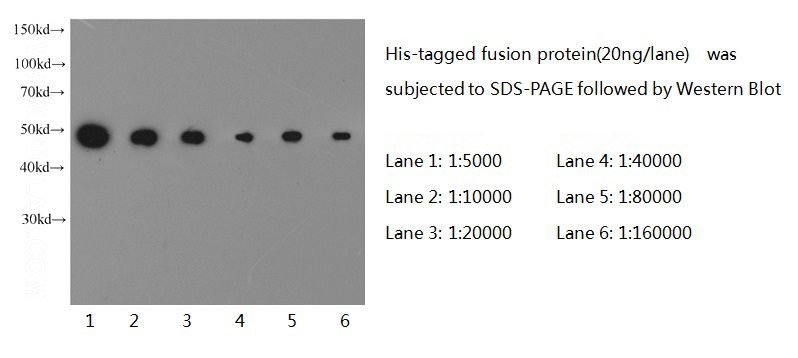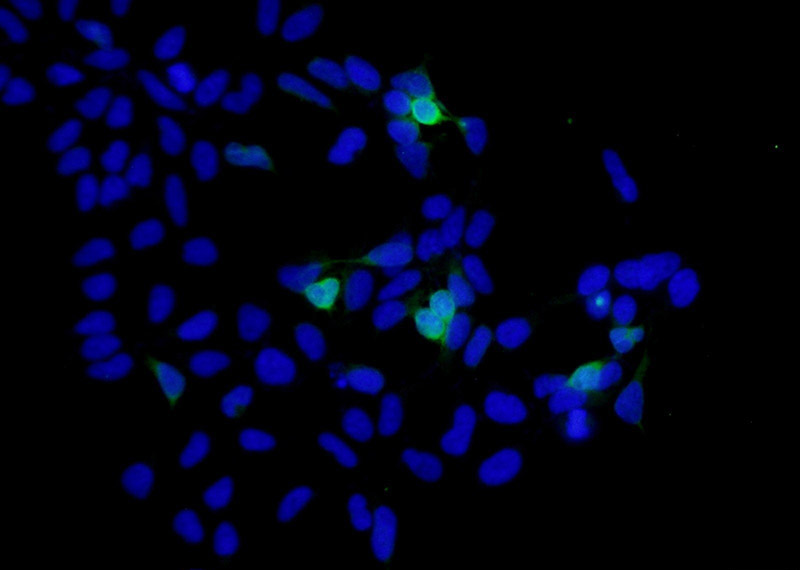-
Product Name
6*His, His-Tag antibody
- Documents
-
Description
6*His, His-Tag Mouse Monoclonal antibody. Positive IP detected in Transfected HEK-293 cells. Positive WB detected in recombinant protein. Positive IF detected in Transfected HEK-293 cells.
-
Tested applications
ELISA, WB, IP, IF
-
Species reactivity
Tag
-
Alternative names
6*His antibody; 6*His antibody; His Tag antibody; 6histag antibody; 6XHis antibody; HHHHHH antibody; HIS antibody; His Tag antibody; HISTIDINE TAGGED antibody
-
Isotype
Mouse IgG1
-
Preparation
This antibody was obtained by immunization of Peptide. Purification method: Protein G purified.
-
Clonality
Monoclonal
-
Formulation
PBS with 0.02% sodium azide and 50% glycerol pH 7.3.
-
Storage instructions
Store at -20℃. DO NOT ALIQUOT
-
Applications
Recommended Dilution:
WB: 1:5000-1:50000
IP: 1:5000-1:50000
IF: 1:10-1:100
-
Validations

Western blot of 6*His-tagged fusion protein with anti-6*HIS tag (Catalog No:117294) at various dilutions.

IP Result of anti-6*His, His-Tag (IP:Catalog No:117294, 7ug; Detection:Catalog No:117294 1:10000) with Transfected HEK-293 cells lysate 300ug.

Immunofluorescent analysis of Transfected HEK-293 cells using Catalog No:117294(6*His, His-Tag Antibody) at dilution of 1:25 and Alexa Fluor 488-congugated AffiniPure Goat Anti-Mouse IgG(H+L)
-
Background
Protein tags are protein or peptide sequences located either on the C- or N- terminal of the target protein, which facilitates one or several of the following characteristics: solubility, detection, purification, localization and expression. His tag is often used for affinity purification and binding assays. Expressed His-tagged proteins can be purified and detected easily because the string of histidine residues binds to several types of immobilized metal ions, including nickel, cobalt and copper, under specific buffer conditions. The His tag antibody is a useful tool for monitoring of the His-tagged proteins, and recognizes His-tags placed at N-terminal, C-terminal, and internal regions of fusion proteins expressed in bacteria, insect, and mammalian cells.
-
References
- Wang YP, Liu D, Guo LJ. Enhanced protective immune response to PCV2 subunit vaccine by co-administration of recombinant porcine IFN-γ in mice. Vaccine. 31(5):833-8. 2013.
- Wang F, Wu Q, Zhang Z, Chen S, Zhou R. Cloning, expression, and characterization of iron superoxide dismutase in Sonneratia alba, a highly salt tolerant mangrove tree. The protein journal. 32(4):259-65. 2013.
- Yang J, Peng Q, Chen Z. Transcriptional regulation and characteristics of a novel N-acetylmuramoyl-L-alanine amidase gene involved in Bacillus thuringiensis mother cell lysis. Journal of bacteriology. 195(12):2887-97. 2013.
- Chen K, Chen S, Huang C, Cheng H, Zhou R. TCTP increases stability of hypoxia-inducible factor 1α by interaction with and degradation of the tumour suppressor VHL. Biology of the cell / under the auspices of the European Cell Biology Organization. 105(5):208-18. 2013.
- Wu Y, Zhao S, Tian H. CPK3-phosphorylated RhoGDI1 is essential in the development of Arabidopsis seedlings and leaf epidermal cells. Journal of experimental botany. 64(11):3327-38. 2013.
- Fang J, Li H, Peng G. Methods for detecting ATP hydrolysis and nucleic acid unwinding of Japanese encephalitis virus NS3 helicase. Journal of virological methods. 194(1-2):33-8. 2013.
- Luan C, Zhang HW, Song de G, Xie YG, Feng J, Wang YZ. Expressing antimicrobial peptide cathelicidin-BF in Bacillus subtilis using SUMO technology. Applied microbiology and biotechnology. 98(8):3651-58. 2014.
- Zhang X, Xiao GG, Gao Y. Characterization of human colorectal cancer MDR1/P-gp Fab antibody. TheScientificWorldJournal. 2013:716289. 2013.
Related Products / Services
Please note: All products are "FOR RESEARCH USE ONLY AND ARE NOT INTENDED FOR DIAGNOSTIC OR THERAPEUTIC USE"
